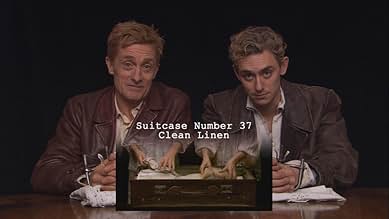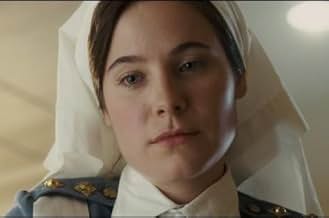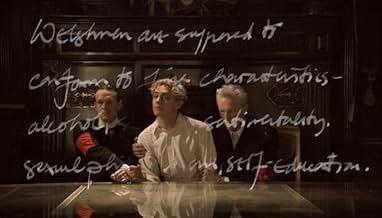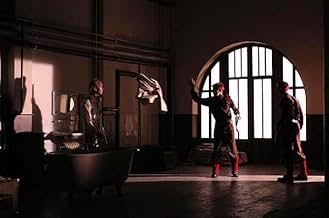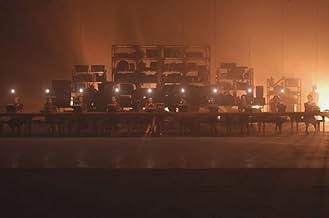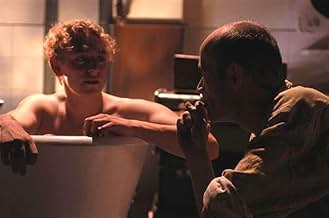The Tulse Luper Suitcases, Part 1: The Moab Story
- 2003
- 2h 7m
The first of three parts, we follow Tulse Luper in three distinct episodes: as a child during the first World War, as an explorer in Mormon Utah, and as a writer in Belgium during the rise o... Read allThe first of three parts, we follow Tulse Luper in three distinct episodes: as a child during the first World War, as an explorer in Mormon Utah, and as a writer in Belgium during the rise of fascism. Packed with stylistic flourishes, it's a dense, comic study of 20th century his... Read allThe first of three parts, we follow Tulse Luper in three distinct episodes: as a child during the first World War, as an explorer in Mormon Utah, and as a writer in Belgium during the rise of fascism. Packed with stylistic flourishes, it's a dense, comic study of 20th century history, revolving around the contents of one man's suitcases.
- Awards
- 1 win & 1 nomination total
- Jan Palmerion
- (as Jordi Molla)
- Pip
- (as Nilo Mur)
- Director
- Writer
- All cast & crew
- Production, box office & more at IMDbPro
Featured reviews
Greenaway continues to evolve his directorial style, overlapping images and sounds, embedding windows within windows, mixing media. The results are often confusing, sometimes stunning, never boring.
I wondered if Greenaway was hinting that this was in some sense an autobiographical piece. Tulse Luper is cited as the author of 'The Belly of an Architect' and in a list of his lost works appears 'The Falls', both earlier films by Greenaway.
Of course it might just be the director playing games. A clip from 'A Zed and Two Noughts' is used at one point, and there is a character named 'Cissie Colpits', the name of the three women in 'Drowning by Numbers'. I suspect there might well have been many more references to earlier films in there.
This is closer in style to 'Properos Books' or 'A TV Dante' than some of his earlier works such as 'The Cook, the Thief, his Wife and her Lover'. Narrative flow has been sacrificed in part for creating a cinematic work of art. Nothing wrong with that in my opinion though, when the result is a film like this. Sit back and let the experience wash over you.
This is the first film that I have watched at a film festival in about ten years that I can honestly say the vast majority of the audience left the theatre in a state of bemused disgust. It was one of the least enjoyable film experiences I have ever had, right up there with Salo, and UFO: The Movie. Maybe if viewed in sequence with the other parts of the production it might have some worth, but i doubt it. At best it may serve as an educational tool to the many film schools out there...
having said all that i still really badly want to see the project as a whole
His fundamental notions of the world are built on overlapping conceptual frameworks, ordered frameworks. In this, he follows the Joycean tradition of "Finnegans Wake," which layered all sorts of frameworks from Kabbalistic, Vican, mythological, even geographic sources. It was all merged according to a dream logic since we had no other template in that day and used every lexical and literary device he could muster.
Where Joyce had to make do with dream-layering, our Peter gets to use already familiar web- referenced multimedia overlays. He surely knows how to use the software to extend the art of editing into new dimensions. Wow, just on that score.
And where Joyce used obtuse frameworks with the intent of his book being a life's reading, Greenaway uses obvious overlapping frameworks: numbers, his own life and the mythology from his prior films. Some categories, like the periodic table. Oddly, he hasn't been as thorough in this film as he has in some others: Vermeer's theories of light, animals, sexual stereotypes, the written word, various frameworks of introspection and reflection. Different slices on gender.
Anyway, the point is that where Joyce was esoteric, Greenaway strives to be obvious, though manylayered, even juvenile, in his frameworks. He wants these to be so simple and grand that he can stretch them to many web sites, films, CDs, games, and (I presume) books and installations. Someone can casually enter a part of the larger work and intuit the order of the thing.
Each fan of Greenaway will have to make her own decisions on what she likes in terms of the different balances he has struck. As for me, I want a tighter integration of framework and image than he has here. This is why I value his "book" films the highest.
What does this add to what we have? Sadly, not much, except an attempt to integrate himself and some of the political sweeps of the ordinary world, which he tags to nuclear control. I've often thought that the artists themselves are dumber than the art they produce and the greater distance we have from their personalities, the better.
If you have talked to Greenaway, you'll see this in a flash. He has some good headlines, having to do with the bankruptcy of narrative in film. But beyond that, his films (some of them) soar, while his own spoken narrative crawls.
Ted's Evaluation -- 3 of 3: Worth watching.
Did you know
- Trivia'Cissie Colpitts' is the name shared by the three main female characters in Triple Assassinat dans le Suffolk (1988), by the same director.
- ConnectionsEdited into The Tulse Luper Suitcases: Antwerp (2003)
- How long is The Tulse Luper Suitcases, Part 1: The Moab Story?Powered by Alexa
Details
- Release date
- Countries of origin
- Official site
- Languages
- Also known as
- Les maletes de Tulse Luper: La història de Moab
- Filming locations
- Production companies
- See more company credits at IMDbPro
Box office
- Budget
- $10,000,000 (estimated)
- Gross worldwide
- $90,071
- Runtime2 hours 7 minutes
- Color
- Sound mix
- Aspect ratio
- 1.85 : 1
Contribute to this page


